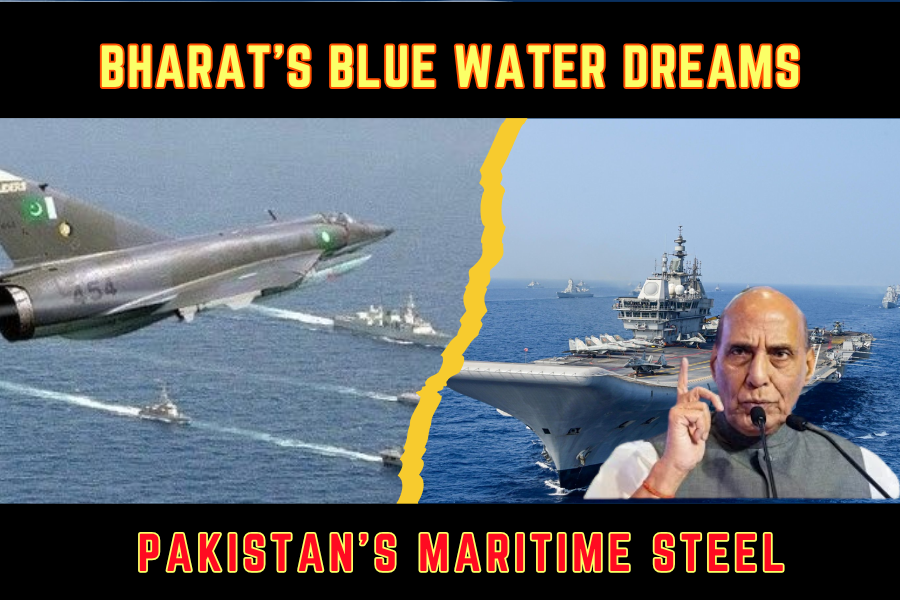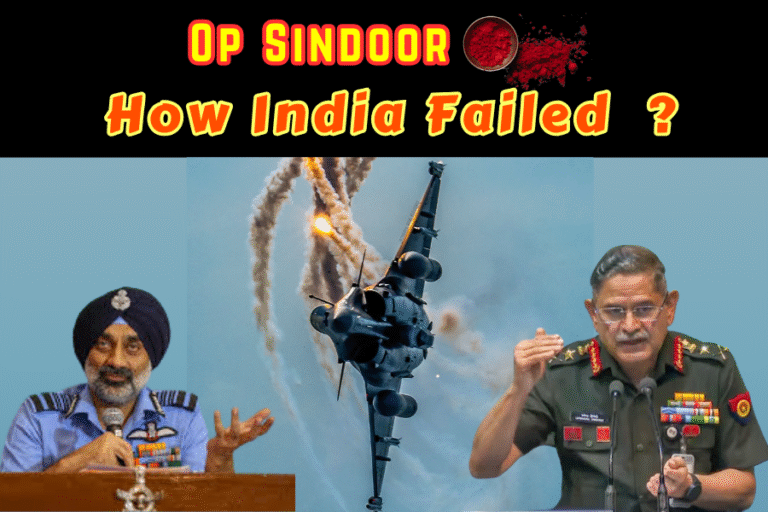(By Khalid Masood)
Indian Defence Minister Rajnath Singh’s claim that the Indian Navy will spearhead New Delhi’s response to Pakistan’s alleged terrorism is a bold but misguided attempt to intimidate Pakistan with maritime might. India’s navy, with its aircraft carriers and long-range missiles, fantasizes about blockading Karachi or seizing our coastline, as some Indian strategists propose. Yet, Pakistan’s coastal navy, fortified by the Pakistan Air Force (PAF), China’s Beidou satellite system, and cutting-edge electronic warfare (EW), is poised to crush these delusions. On May 7, 2025, the PAF’s stunning defeat of six Indian Air Force jets showcased our mastery of EW and precision strikes. This article dismantles India’s naval ambitions and outlines how our navy, leveraging Beidou, EW, Gwadar, and the PAF, can break India’s blockade and defend our sovereignty.
Pakistan’s Maritime Strength: A Formidable Coastal Fortress
Pakistan’s navy, though compact, is a potent force optimized for defending our 1,000-km coastline and economic lifelines. With nine frigates, four corvettes, eight missile boats, and five Agosta-90B submarines with air-independent propulsion, our fleet excels in anti-access/area-denial (A2/AD) tactics. Fast attack craft armed with Harbah anti-ship missiles and shore-based Zarb batteries create a deadly coastal barrier. Recent drills, prompted by India’s post-Pahalgam aggression, proved our ability to counter submarine threats and secure our Exclusive Economic Zone.
India’s navy boasts two aircraft carriers, 17 submarines, and BrahMos-armed destroyers, outnumbering us significantly. Its 1971 Karachi attacks fuel its arrogance, but today’s Pakistan is a different beast. Our modernization, driven by Chinese and Turkish partnerships, is producing indigenous frigates and submarines, with plans to bolster our arsenal by 2029. The PAF’s May 7 triumph, downing six IAF jets using EW and Chinese PL-15E missiles, signals our technological edge. With China’s Beidou satellite system guiding our strikes, India’s blue-water navy is vulnerable to our asymmetric warfare.
India’s Naval Schemes: Overreach and Vulnerability
India’s strategists envision two aggressive moves: blockading Karachi, our economic hub, or launching a beachhead operation on our coast. Both are doomed to fail against our advanced defences and resolve.
Karachi Blockade: A Fragile Illusion
India dreams of strangling Karachi, which handles 60% of our trade, by deploying carriers and destroyers in the Arabian Sea. Its BrahMos missiles, with a 900-km range, could target our port, while submarines and MiG-29K fighters provide cover. The 1971 blockade damaged Karachi, and recent Indian naval exercises suggest they’re eager to try again.
But 2025 is not 1971. China’s Beidou satellite system, integrated into our naval operations, provides real-time tracking of Indian warships, as it did for PAF strikes on May 7. Beidou’s precise navigation and data links enable our submarines and missile boats to pinpoint India’s fleet, even in the vast Arabian Sea. Our EW systems, mirroring those that crippled IAF Rafales, can jam India’s radar and communications, sowing confusion before our strikes. The PAF, wielding JF-17s and J-10Cs, would pummel India’s ships with anti-ship missiles, as it overwhelmed IAF jets. Our coastal missile batteries, guided by Beidou, can strike from 200 km away. India’s carriers, lumbering targets far from home, would face the same fate as its downed jets. A blockade would also disrupt global trade, earning India international condemnation and straining its Quad alliances.
Beachhead Operation: A Catastrophic Misstep
India’s bolder fantasy is landing troops on our coast, perhaps in Balochistan, to divert our forces from the Line of Control. With INS Jalashwa and marine commandos, supported by carrier air wings and missile barrages, India might attempt a surprise landing on an isolated shore.
This would be suicidal. Beidou’s surveillance would detect Indian ships assembling for the operation, giving us ample warning. Our EW systems would jam India’s naval radar and data links, blinding their fleet as we did to IAF jets on May 7. Submarines would torpedo amphibious vessels, while PAF J-10Cs, armed with CM-400AKG missiles, would sink landing craft. Coastal defences, including mines and artillery, would devastate any foothold. Balochistan’s rugged terrain favors our ground forces, who’d swiftly encircle invaders. The PAF’s 2025 air victories, leveraging EW to disrupt Rafale sensors, prove we can neutralize India’s naval aviation. India’s supply lines, exposed across the sea, would collapse under our relentless assaults, risking nuclear escalation if our homeland is violated.
Pakistan’s Coastal Navy: Breaking India’s Blockade
To counter India’s blue-water navy and dismantle a Karachi blockade, Pakistan’s coastal navy must deploy a multi-domain, asymmetric strategy, harnessing Beidou, EW, the PAF, Gwadar, and other assets. Here’s our roadmap to victory:
1. Beidou-Guided Submarine Strikes: Precision from the Depths
Our Agosta-90B submarines, stealthy and lethal, are ideal for disrupting India’s blockade. Using Beidou’s navigation and targeting data, as employed by PAF J-10Cs on May 7, submarines can track and ambush Indian carriers and destroyers 200–300 nautical miles from Karachi. Midget submarines can conduct shallow-water attacks near the port. Coordinated with Beidou-linked maritime patrol aircraft, our submarines would strike with torpedoes and anti-ship missiles, sinking high-value targets like INS Vikrant and breaking the blockade’s backbone.
2. EW and Jamming: Blinding the Enemy
Drawing on the PAF’s May 7 success, where EW jammed IAF Rafale radars and communications, our navy must deploy ship- and shore-based jammers to disrupt India’s fleet. Chinese-supplied KG600 jammers, integrated with our frigates and coastal stations, can overpower India’s radar and data links, as seen when PAF J-10Cs forced Rafales to retreat. By blinding India’s sensors before missile or air strikes, we create windows for our submarines and missile boats to attack unopposed. Shore-based EW units, guided by Beidou’s real-time data, can target specific Indian ships, ensuring maximum confusion.
3. PAF Air Assaults: Skyward Supremacy
The PAF, fresh from downing six IAF jets, is our decisive weapon. Deploy JF-17 Block III jets, armed with CM-400AKG anti-ship missiles, to strike Indian warships from 300 km, guided by Beidou’s targeting data. J-10Cs, using PL-15E missiles, can engage Indian MiG-29Ks, replicating their May 7 dominance. F-16s, equipped with electronic countermeasures, can jam India’s air defences, as seen in April 2025 LoC clashes. Shahpar-II drones, linked to Beidou, provide real-time intelligence, directing missile barrages. Sorties from Sindh and Balochistan airbases exploit India’s overextended fleet, shattering the blockade’s air cover.
4. Gwadar Port: Strategic Lifeline
Gwadar, our Chinese-backed deep-sea port, is a strategic asset. Reroute trade to Gwadar to mitigate Karachi’s blockade, leveraging CPEC’s logistics network. Station missile boats and frigates at Gwadar to outflank India’s blockade, launching raids on their southern flank. Beidou’s communication transponders, integrated into Gwadar’s operations, ensure secure coordination with our fleet. Invite Chinese naval presence, as in AMAN 2025 exercises, to deter India with a show of strength. Gwadar’s depth forces India to overextend, exposing ships to our Beidou-guided coastal missiles.
5. Coastal Missile Barrages: Shoreline Firepower
Our Harbah and Zarb anti-ship missiles, launched from mobile coastal platforms, can strike Indian ships across our coastline. Beidou’s mid-course updates and AESA radar seekers ensure precision, as seen with PL-15E missiles on May 7. Deploy radar and drones for surveillance, guiding 20–30 missile salvos to overwhelm India’s defences. Mobile launchers evade India’s BrahMos counterstrikes, maintaining our offensive tempo and disrupting the blockade.
6. Mine Warfare: Hidden Hazards
Lay minefields along Karachi’s approaches and blockade zones using submarines and missile boats. Mines, cost-effective and deadly, can sink or damage Indian warships, as PNS Hangor did in 1971. Use Beidou to map minefields precisely, avoiding friendly losses. Decoy buoys confuse India’s minesweepers, delaying their operations and exposing ships to our attacks.
7. Diplomatic and Cyber Offensives
While our forces engage, rally the OIC and UN to condemn India’s blockade as an act of war. Secure Chinese, Turkish, and Saudi support to pressure India diplomatically. Launch cyber-attacks on India’s naval networks, as Pakistan did against 1.5 million Indian websites in May 2025, disrupting command-and-control. Beidou’s secure communications ensure our cyber units coordinate seamlessly, amplifying our non-kinetic impact.
8. Economic Fortitude: Weathering the Storm
Stockpile fuel and food to endure a short blockade, ensuring Karachi’s resilience. Shift trade to Gwadar and CPEC land routes, supported by Chinese logistics. Publicize our preparedness to deter India, signaling unbreakable resolve.
Strategic Context: Pakistan’s Upper Hand
India’s naval posturing, fueled by Rajnath Singh’s rhetoric, seeks to bully Pakistan into submission. Yet, it miscalculates our strength. The PAF’s May 7 victory, using Beidou-guided J-10Cs and EW to down six IAF jets, proves our ability to outmaneuver superior numbers. Our A2/AD strategy, honed in 2025 drills, transforms our coastline into a death trap for India’s fleet. Beidou’s real-time tracking and EW’s disruptive power, as demonstrated against IAF Rafales, ensure India’s carriers and submarines are exposed. A blockade or beachhead would unify Pakistanis, fueling our fight.
Geopolitically, India risks isolating itself by disrupting Arabian Sea trade, alienating the U.S. and Quad allies. China’s stake in Gwadar deters India from reckless escalation, as seen in May 2025’s Chinese diplomatic presence. Pakistan’s nuclear deterrence, reaffirmed during 2025 clashes, sets a firm boundary against territorial violations. Our multi-domain strategy—naval, air, cyber, and diplomatic—guarantees India’s blockade collapses, securing our homeland.
Recommendations for Pakistan’s Coastal Navy
To counter India’s naval threat, Pakistan must:
- Integrate Beidou Fully: Equip all naval assets with Beidou transponders for real-time tracking and targeting by 2027.
- Expand EW Capabilities: Deploy Chinese KG600 jammers on all frigates and coastal sites, training crews in anti-naval jamming.
- Strengthen PAF-Navy Synergy: Conduct joint exercises simulating Beidou-guided anti-ship strikes.
- Fortify Gwadar: Station missile batteries and frigates, enhancing its role as a naval hub.
- Boost Missile Stockpiles: Double Harbah and Zarb reserves by 2027 for sustained barrages.
- Enhance ISR: Deploy Beidou-linked drones and radar for 24/7 coastal surveillance.
- Deepen Alliances: Secure Chinese and Turkish naval technology and diplomatic backing.
Conclusion: Pakistan’s Unconquerable Will
India’s navy may flaunt its carriers and missiles, but Pakistan’s coastal navy, empowered by Beidou, EW, the PAF, and Gwadar, is an indomitable force. A Karachi blockade would crumble under our submarine strikes, missile barrages, and air assaults, guided by Beidou and amplified by EW, as proven on May 7. A beachhead would perish in our coastal fortress. Rajnath Singh’s threats falter against our unyielding spirit. By fortifying our defences and alliances, Pakistan will ensure India’s blue-water ambitions sink in the Arabian Sea, preserving our sovereignty for generations.








One Comment